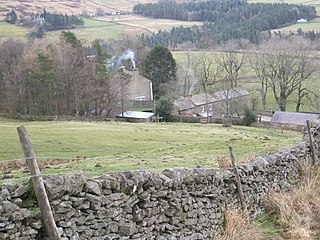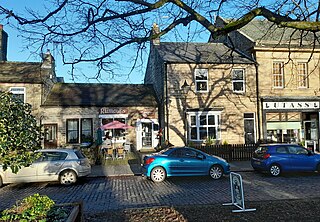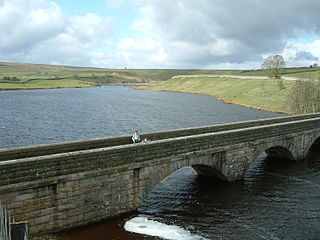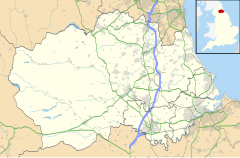
Teesdale is a dale, or valley, located principally in County Durham, North East England. It is one of the Durham Dales, which are themselves part of the North Pennines, the northernmost part of the Pennine uplands.

Holwick is a hamlet and civil parish in Teesdale, County Durham (district), England. Located in the Pennine hills, the hamlet consists of a few houses spread along a road in the pattern of a linear settlement. As the population taken at the 2021 Census was 75.

Butterknowle is a village in Teesdale, County Durham, England. Butterknowle is situated between the market towns of Bishop Auckland and Barnard Castle. It has an attractive rural setting within the Gaunless Valley, overlooked by the gorse-covered Cockfield Fell. The fell itself is a scheduled ancient monument, containing evidence of Roman settlements and a medieval coal mine (Vavasours), thought to be the earliest inland colliery recorded.

Aukside is a hamlet in the civil parish of Middleton in Teesdale, in County Durham, England. It is situated on the north side of Teesdale, a short distance from Middleton-in-Teesdale. It was originally called Hawk Side. This can be seen in early Ordnance Survey maps.

Bowbank is a hamlet in Lunedale, a side valley of Teesdale in County Durham, England. It is within Lunedale civil parish and is situated on the B6276 road, 1 mile (1.6 km) south of Middleton-in-Teesdale and 8 miles (13 km) north west of the town of Barnard Castle.
Gilmonby is a village in the Pennines in County Durham, England. it is situated a short distance to the south of Bowes, in the vicinity of Barnard Castle. The population taken at the 2011 Census was less than 100. Information is kept in the Bowes parish details. It is traditionally located in the North Riding of Yorkshire but along with the rest of the former Startforth Rural District it was transferred to County Durham for administrative and ceremonial purposes on 1 April 1974, under the provisions of the Local Government Act 1972.

Lartington is a village and civil parish about 2 miles (3 km) west of the town of Barnard Castle, in Teesdale, in the Pennines of England. The 2011 Census recorded the parish's population as 135.

Bowlees is a small village in County Durham, England. It is situated near Newbiggin, on the other side of Teesdale from Holwick.

High Dyke is a hamlet in County Durham, England. It is a short distance to the north of Middleton-in-Teesdale and within the civil parish of the same name. It is named High Dike on an Ordnance Survey map published in 1920 and lies on and around the 1,000 feet (300 m) contour line. Silver-lead ore was mined here in the 19th-century by the London Lead Company; several old shafts are marked on the map.

Middleton-in-Teesdale is a market town and civil parish in County Durham, England. It is in Teesdale, on the River Tees's north banks, and surrounded by the North Pennines. The town is between Eggleston and Newbiggin, a few miles to the north-west of Barnard Castle. In 2011 it had a population of 1137.

Headlam is a hamlet and civil parish in County Durham, England. It lies to the west of Darlington. In 2021 the parish had a population of 41. The hamlet has 14 stone houses plus 17th-century Headlam Hall, now a country house hotel. The village is set around a village green with a medieval cattle-pound and an old stone packhorse bridge across the beck. Headlam is classed as Lower Teesdale and has views to the south as far as Richmond and to the Cleveland Hills in the east.
Forest-in-Teesdale is a village in County Durham, England. It is situated in upper Teesdale, on the north side of the Tees between Newbiggin and Langdon Beck, and is in the civil parish of Forest and Frith.

Langdon Beck is a hamlet in the civil parish of Forest and Frith, in County Durham, England. It is situated in upper Teesdale, between Forest-in-Teesdale and Harwood, halfway between Penrith and Durham. It is a stronghold for the black grouse, one of the few sites for them in the North of England.

Middle Side is a hamlet in the civil parish of Middleton in Teesdale, in County Durham, England. It is situated on the north side of Teesdale between Middleton-in-Teesdale and Newbiggin.

Bishop Auckland is a constituency in County Durham that is represented in the House of Commons since 2024 by Sam Rushworth of the Labour Party.

Baldersdale is a dale, or valley, on the east side of the Pennines in England, northwest of Barnard Castle. Its principal settlements are Hury and Briscoe. Baldersdale lies within the traditional boundaries of the North Riding of Yorkshire. Under provisions of the Local Government Act 1972, it was incorporated into County Durham for administrative purposes on 1 April 1974, along with the rest of the former Startforth Rural District.

The Balder is an English river that rises on the eastern slope of Stainmore Common in the Pennine Chain and flows eastwards for about 23.4 kilometres (14.5 mi), before joining the River Tees at Cotherstone.

Lunedale is the dale, or valley, of the River Lune, on the east side of the Pennines in England, west of Middleton-in-Teesdale. Its principal settlements are Grassholme, Thringarth and Bowbank.

County Durham is a unitary authority area in the ceremonial county of County Durham, England. It is governed by Durham County Council. The district has an area of 2,226 square kilometres (859 sq mi), and contains 135 civil parishes. It forms part of the larger ceremonial county of Durham, together with boroughs of Darlington, Hartlepool, and the part of Stockton-on-Tees north of the River Tees.


















